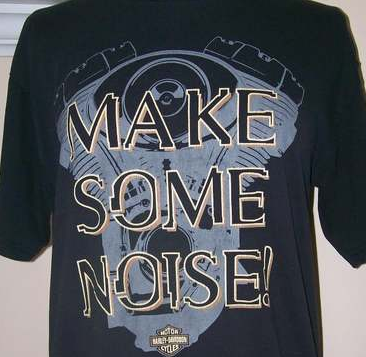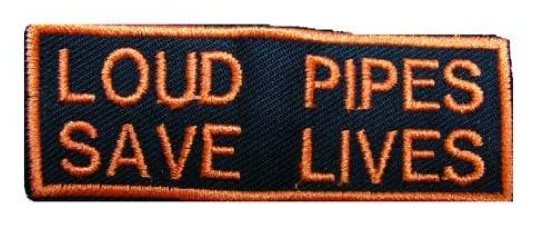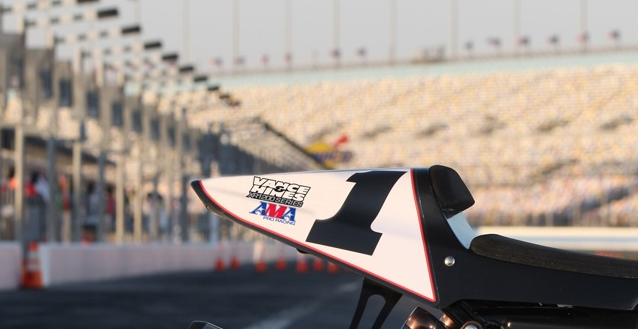'Loud Pipes Save Lives' But Who Will Save Loud Pipes? (Update: AMA Responds)
by Abe Sauer

Last week, Governor Schwarzenegger signed a number of bills. The one in the spotlight was SB1449, which decriminalized marijuana possession. But he also signed SB435, a far more controversial bill empowering police to cite motorcycles for noise pollution. The bill will also require a motorcycle to display its stock or aftermarket exhaust system’s EPA stamp, certifying compliance with federal laws that have been in place, if unenforced, for a quarter century. Similar legislation has recently been passed or is pending in other states including Oregon and Maine and individual communities from Denver to Green Bay.
The Motorcycle Industry Council and the American Motorcyclist Association (AMA) opposed SB435. The AMA did this despite its “strong opposition to excessive motorcycle sound.”
In 1925, The Berkeley Gazette called out the “demoniacal motorcycle” on account of its noise. Three years later, the Pittsburgh Gazette declared that “the explosions of a motorcycle exhaust are bound to irritate.” By the late 1960s, a Spokane Daily headline read “Noisy Mufflers Prompt Promise of a Crackdown.” That crackdown wouldn’t come until the early 1980s, when the EPA issued new standards limiting the motorcycle exhaust noise. But it was too late. By then, “loud pipes” were more than the collateral of combustion engineering, they were the soundtrack for culture war.
A decade after the EPA’s big government, nanny state regulations limiting motorcycle noise to about 80 decibels, riders had found a rallying cry. In 1990, The St. Petersburg Times noted “’Loud Pipes Save Lives’ is the credo of those who think motorists will respect bikers more if they hear them before they see them.”
Renee “Belt Drive Betty” Charbonneau, editor of The Busted Knuckle Chronicles and a Canadian, explained “loud pipes save lives” to me: “Riders found that when a vehicle tried to violate their lane/right of way their horn was ineffective and that a quick rap on the pipes alerted the driver that they were about to drift into someone. This is a defense that works in urban traffic situations where you have two or more lanes and an inattentive person on their cell phone, talking to someone else in the vehicle and the driver is not generally paying attention to where they are going. When they, the automobile driver, are right beside you and do not turn their head before moving over, this is the prime time in urban riding when ‘loud pipes save lives.’
Another rider, Carie R. said, “I absolutely believe that loud pipes save lives for a couple of different factors. One, the obvious.. if you are heard, you are more likely to be seen. Two, most bikers or bike organizations do many, many bike runs in order to raise money for things like the American Cancer Society, March of Dimes, etc. which also, in the end, can also save lives.” Carie’s interpretation is credible. A recent ride in Tomahawk, WI, raised much-needed money for muscular dystrophy causes.
But couldn’t an aftermarket horn be a better replacement for loud pipes, sending the noise forward toward the danger, instead of backward away from it? (Ironically, stock horns are no louder than stock pipes.) “I think that there are a lot of us looking at going to the air horns and trying to find something that will fit our machines,” said Belt Drive Betty. But as she points out, the aftermarket for horns is terrible. Harley-Davidson, while offering a robust lineup of aftermarket exhausts, offers just one full horn.
A registered nurse and a health crisis worker who goes by the name Jimmy Swinghammer told me, “Safety is a tangible and credible position from which to defend loud pipes to be sure, and, yes, I stand by that fully.”
Sweet Jimmy doesn’t buy the horn bologna. “Lets say I’m considering a purchase,” he tells me. “I’m not likely to say, ‘You know I’ll take that one with the muted exhaust and the awesome horn.’ If you’ve never sat on 1,200 CCs or more, bolted to a steel frame… felt it vibrate beneath you… passively idling, growling rhythmically, latent power waiting to be unleashed with a quick twist of the throttle in an explosion of combustion and precision engineering… felt that power beneath you as the bike moves off, the freedom, that noise. It’s a visceral part of the experience. You should try it if you haven’t. It’s an incredibly liberating thing.”
And here is one overlap where the “loud pipes save lives” apostles do their cause few favors by diluting their safety argument with one about “freedom.” Echoing Jimmy, Biker News Online notes: “Laws against loud motorcycle exhaust is simply the justification for stopping bikers from enjoying too much freedom.” After sanely and reasonably defending the safety position of “loud pipes” movement, Belt Drive Betty tells me, “The political issues surrounding discrimination of any type are something every voting human being should be aware of, sir. Ask any black person, native American Indian, every refugee, females, gay persons… discrimination is very political in nature and requires a certain amount of empathy to understand the costs. When you allow one form of discrimination, you open the door for other rights and freedoms become eroded.” Taken to the fringe of reason, one op-ed equates loud pipes laws with charging all men with rape “because they have the right equipment.”
Jerry Smith, a veteran rider, motorcycle writer and editor of Cycle Guide Magazine told me, “Common sense argues against the hypothesis that a loud motorcycle is a conspicuous motorcycle. Ask anyone who drives a fire truck, an ambulance, or a police car how often traffic up ahead fails to yield, even with an ear-piercing siren shrieking at them from behind. Unlike the siren on an emergency vehicle, which directs sound forward, the exhaust system on a motorcycle directs sound to the rear, where a car ahead of you is even less likely to hear it.” Smith goes on to point out all the niggling ironies accompanying the loud pipes “safety” arguments made by riders who never wear helmets, have never taken a safety class and wear dark colors on a dark bike.
Andy Ford, a leading advocate member of a coalition against noise pollution called NoiseOff, doesn’t think the motorcycle community has any hope of policing itself and sees law enforcement as the only way. “It’s my belief that riding loud is eventually going to become as acceptable as smoking inside a hospital or restaurant which not many years ago was not only legal but was considered by most people to be normal and acceptable behavior,” Ford said. “Now in Maine, no one can smoke within 50 feet of a hospital nor in a restaurant’s outside patio where there are tables.” The group’s Facebook page and website offer a wealth of resources and news about specific community’s battles against loud pipes.
And yet Ford’s vision of the future may inspire unexpected allegiances within communities who feel persecuted by Those Who Know Best. Smokers. Pregnant women. Raw milk aficionados. “Gangsta’” pant sartorialists. Aluminum bat users. Urban rooster farmers. Tanners. And the city of Grand Forks, North Dakota-who sent me a warning threatening a $150 fine because my property’s grass was “unkept.”

Of course “Loud Pipes Save Lives” has existed within the motorcycling community for decades. The older riders I spoke with remembered hearing it too long ago to place. But through the 1990s, the made-for-bumper-stickers motto gained in popularity, as did the mindset it represented, thanks to a shift in motorcycling demographics. Where the defense of loud pipes had, to that point, been about freedom and liberty, it now became about safety and social responsibility. And the practice of riding with loud, modified exhausts, previously popular primarily only with those one might characterize as “bikers,” suddenly became an acceptable behavior for “weekend warriors,” the fastest growing demographic of “bikers.”
Between 1995 and 2005, motorcycle sales in the U.S. nearly quadrupled, peaking in value over $14 billion. (Crashing alongside everything else, sales in 2009 were about half of 2005’s 1.1 million.) A lot — a lot — of those bikes were sold to Boomers. The average age of a Harley-Davidson rider went from 42 in 2004 to 49 in 2009. The weekend warriors wanted to ride loud; but as rapidly-aging, cul-de-sac-living, Monday-through-Friday clock-punchers, they had a hard time buying the classic “if it’s too loud, you’re too old” aggressive libertarian justification for doing so. “Loud pipes save lives” fit perfectly. As Jimmy Swinghammer told me, “Freedom is a fuzzy area from which to debate loud pipes. Safety is not.”
This new demographic, flush with its ready-for-slaughter wallets fattened on third-home mortgages, also perfectly fit the industry’s aims. Because it turns out what loud pipes save even more than lives is bottom lines.
With millions more motorcycles on the road, the motorcycle aftermarket trade bulked up. Just as the middle class decided a bathroom just wasn’t a bathroom without marble and a kitchen without granite was unlivable, riders found stock bikes, and their EPA-muted exhausts, unacceptable. Harley-Davidson sold t-shirts reading “Make some noise.”
But eventually, average Americans rebelled. More bikes on the road with louder exhausts meant more infants woken at midnight and more neighborhood windows rattling. The industry figured it out: outrage is bad for long-term business. Industry organizations and manufacturers like Harley-Davidson began PR campaigns against what they classified as the irresponsible behavior of a few problem bikers. But Frankenstein was already walking.
Harley COO Jim McCaslin said in his address, “[W]e, not just the Motor Company, not just the Harley-Davidson dealers, not just a handful of riders, we all, every Hog lovin’ one of us, must do everything we can to protect our sport and keep it as strong as it is today. We must take our turn, as more than a century-worth of Harley riders has before us, in guarding our sport… No one expects everyone to change out their straight pipes overnight. But we all must consider changing out our thinking. We need to think about the consequences our actions have on others, before others take action against us.” That was 2006, the first year in 13 that U.S. motorcycle sales had declined.
McCaslin’s address coincided with a very public Harley announcement ceasing sale and distribution of the straight pipes sold by its sub-brand Screamin’ Eagle.
In June, I found those supposedly discontinued Screamin’ Eagle II pipes hanging on the wall of Mischler’s Harley-Davidson in central Wisconsin. Asked if their service center could install the pipes on my bike, the Harley rep told me, “sure.”
“To respond to your inquiry, Harley-Davidson Motor Company has not distributed Screamin’ Eagle II exhaust systems since 2006. We sell only EPA compliant parts for street use motorcycles. While our dealers are independently owned businesses, and therefore determine what products or components they will sell, we strongly encourage them to sell only compliant components for street use motorcycles. We also communicate regularly with dealers and riders to raise awareness for how excessive motorcycle noise affects others.” That is Harley’s official response to questions about how an official Harley-Davidson dealership could be selling and installing excessively loud Screamin’ Eagle pipes four years after they were supposedly discontinued.
The company declined to share any of the “regular” communications it claims to have with its dealers to “raise awareness for how excessive motorcycle noise affects others.”
New versions of Harley-Davidson’s Screamin’ Eagle pipes have been quieted down. So has its marketing campaign. Gone are the days of “Make some Noise” t-shirts. The product copy for the new Screamin’ Eagle Slip Ons replaces “loud” with “…factory tuned to deliver an aggressive exhaust note and improved performance comparable to Screamin’ Eagle II mufflers.”
“Make some Aggressive Exhaust Notes” t-shirt, coming soon.
Also claiming to be locked in battle against loud pipes is The American Motorcycle Association, the group that opposed California’s new noise law. The AMA’s position on the issue is that “few other factors contribute more to misunderstanding and prejudice against the motorcycling community than excessively loud motorcycles. All motorcycles are manufactured to meet federally mandated sound control standards. Unfortunately, a small number of riders who install unmuffled aftermarket exhaust systems perpetuate a public myth that all motorcycles are loud.”
The AMA has vigorously fought laws that intend to curb motorcycle noise, especially what’s known as the “label match” ordinances (like in California) which require bikes to have EPA stickers on their exhausts proving they conform to federally-set noise levels. The AMA fights such ordinances on the basis that the laws “miss the mark by singling out motorcyclists with ordinances and laws that are unfair, impractical and unenforceable.” The AMA instead supports the J2825 standard which is a stationary test requiring law enforcers to use a very specific sound meter that requires constant calibration and special training for users. The meter is also not free, nor is the training, and it would be on the individual departments to buy them and equip officers.
In emails with The Awl, the AMA insisted that “No single segment of the motorcycling community — riders, event organizers, retailers and distributors, original equipment and aftermarket manufacturers, law enforcement and the safety community — can single-handedly solve this problem.”
Even though the AMA’s statement says no single actor can solve this problem, the group exerts most of its energy in the fight against loud pipes on individual riders. Despite the AMA’s statement about no group being able to “single-handedly solve this problem,” aftermarket manufacturers could in fact (nearly) single-handedly solve this problem. When The Awl asked if the AMA has no efforts directly addressing aftermarket manufacturers, we were told, “With 240,000 members, the AMA can best influence the aftermarket through the purchasing decisions of its members. That’s fairly direct.”
Is it?
When I asked the AMA for hard examples of what it was doing to “influence the aftermarket through the purchasing decisions of its members,” it pointed to press releases, a few PSAs and that “AMA President and CEO Rob Dingman talks about this issue regularly in public appearances at AMA functions and motorcycle rallies.” He also talks, and talks, and talks in pieces such as this Boomer Biker three part series, “Threats to Motorcycling in America.”

The AMA might not be interested in putting any kind of pressure on aftermarket manufacturers because those same aftermarket manufacturers fund the AMA. In fact, the Association just announced a new race series partnership with sponsor Vance and Hines, a leading producer of aftermarket exhausts such as the “Straight Shots,” called by some riders comparable, or louder, than the Screamin’ Eagle IIs.
At the same time that Harley-Davidson’s COO Jim McCaslin addressed the noise issue he called riding “primeval” and a “leftover evolutionary seventh sense that’s triggered when we hit the ignition and fire brings our V-twins to life.” Like countless enthusiasts, and religious zealots, many riders romanticize motorcycling, elevating the act of simply traveling on a mechanized conveyance to something transcendent, thus allowing the enthusiasm to be defensible on terms beyond reason.
Like with gun ownership, or religious zealotry, this romanticization invites a paranoid sense of oppression and clouds the vision of adherents in the face of rationality or data. Especially data. Despite all the groups, bumper stickers, and rather convincing individual anecdotes, there are no data suggesting loud pipes serve any safety purpose whatsoever. No insurance company, including the Harley-Davidson-branded insurer, offers any discount for adding louder pipes.
And it is critical this data remains lacking, because if the “loud pipes save lives” advocates are correct, then Governor Schwartznegger and legislators signing similar bills limiting motorcycle exhaust noise are going beyond harassing law-abiding riders. If loud pipes really do save lives, then these lawmakers are actively risking the flesh-and-blood lives of their constituents in the interest of the quality-of-life lives of others.
UPDATE: The AMA writes in to update its relationship with AMA Racing.
“Apparently you have confused the American Motorcyclist Association with AMA Pro Racing, a separate for-profit business owned by the Daytona Motorsports Group (DMG) out of Florida. AMA operated several professional racing series for many years before selling them to DMG in 2008. While DMG is an AMA corporate member, the AMA has no stake in DMG, or vica versa. One could argue that your confusion is understandable given that DMG also bought the name “AMA Pro Racing” and its logo…”
The AMA adds: “More to the point, only one aftermarket manufacturer among many, SuperTrapp Industries, is an AMA corporate member (see the list at http://americanmotorcyclist.com/whatis/corpmbrs.asp).”
SuperTrapp Industries offerings include the “Mean Mothers Long Drag Pipes.” Also, the AMA fails to characterize Harley-Davidson, an AMA member, as an aftermarket producer despite its Screamin’ Eagle sub-brand being one of the largest manufactures in the aftermarket. See above for my experience with Harley-Davidson.
The AMA insists its position on loud pipes has cost it “many individual members” and aftermarket cooperate members.
Abe Sauer likes both peace and quiet and freedom.
